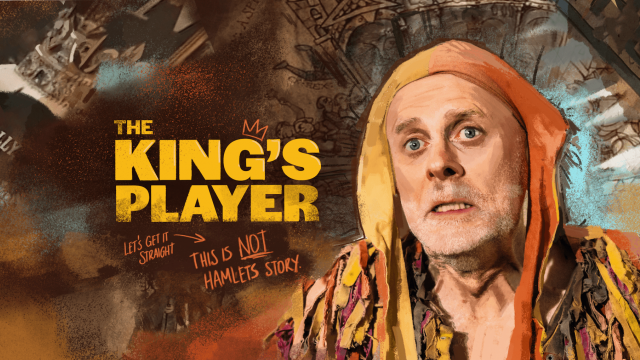The King’s Player
As his eponymous character, Tref Gare is dressed in motley, a barefoot, grubby traveling player of the Middle Ages. Before the show – in costume but not yet in character - he roams the audience (some of whom, I notice, are very good Melbourne actors) as they arrive, welcoming them and explaining his intriguing backdrop screen which is behind an otherwise bare stage. The screen is dense with hectic imagery drawn by a skilled hand and it’s by Jen Ellis Stevens.
We make out what looks like half the Globe Theatre, ringed with spectators, but looking closer we notice the Grim Reaper, various animals, a train and other anachronisms. Tref Gare talks to us softly two by two, or three, and he seems like a most likeable chap with a most mellifluous voice. He asks what we can see on the screen, and we pick things out. I wonder why he needs to do this. As an element in his show, shouldn’t it speak for itself? But perhaps he’s creating an intimate, involved atmosphere, and ascertaining our level of education or perspicacity. At any rate, it turns out that his show does indeed reference many of the screen’s images - but also that his questions and explanations are really rather unnecessary.
The Companion asks if he wrote his show, but Gare resists the ‘written by’ label. He says the show grew and evolved over the years… It grew out of a series of improvisations and he began melding it into a show about 1992 when, as a jobbing actor fascinated by the medieval period, he saw parallels between the uncertain life of a travelling player in the Middle Ages and the life of the intermittently employed, hungry, desperate modern actor. And indeed, that is what The King’s Player is about – actors and acting.
It's up to us to see the parallels, but the show is a narrative about an aspiring medieval actor, who can’t come at his father’s trade of blacksmith and goes on the road and into the very uncertain show biz. His tale is told in a mix, an amalgam, of characters - sixteen in all – and narrative, mime and songs. Elements prefigured on the screen pop up. Gare is totally unafraid of blatant anachronisms - as long as they are on theme – and so we get snatches of opera or modern musicals about artists or the show business.
His character’s ambition is to be permanently employed – and therefore no longer poor, cold, hungry and dirty. He hears they’re looking for players at Elsinore Castle… Could this be his chance to become a king’s player? In a bit of a twist from the original, he's recruited directly by a fey, lisping Hamlet who wants to stage a play called The Murder of Gonzago. Our hero naturally, confidently claims to know this play… to be performed that night. Oh-oh. Can he do it?
Gare trained in physical theatre, so his miming is always clear and spot on. His switches into his various characters likewise. He sings very convincingly. The problem here comes back to his resistance to the idea of written by. Although there is indeed a central concept, the focus is blurry, the pace unvaried, and the concatenation of elements starts to feel too random, too inclusive – as if the principle has been ‘that’s funny, stick it in.’
Despite Gare’s years of experience and his winning persona, his show gets repetitious and rambling, and the gags start to fall flat. There were shrieks of laughter from some sections of the audience, but my sense of things was more a feeling of rather charitable bemusement. We’ve seen Gare in other contexts, such as his Shepherd (with trombone) in a Melbourne Shakespeare Company The Winter’s Tale, in which he proved a brilliant comedian. But that show had a different writer.
Michael Brindley
Subscribe to our E-Newsletter, buy our latest print edition or find a Performing Arts book at Book Nook.

